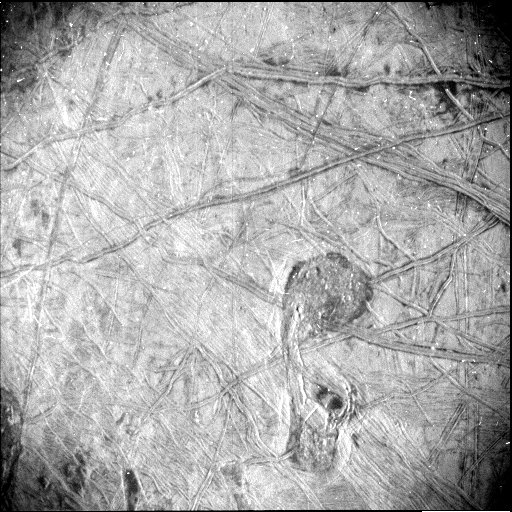In March, Austin has been treated to two very special talks on a space mission set to launch in October. The Europa Clipper mission will visit Jupiter’s moon Europa in 2030, and will remain in orbit there for an extended study. Europa is a special target of the space agency NASA because it may harbour life.
At SXSW, Dr. Lori Glaze of NASA’s Planetary Science Division spoke about how humans study the solar system. “We design these spacecraft that go out into the solar system to explore, and we start to answer some questions, but inevitably every time we come back with even more questions. We learned one piece that’s new, and then we have to reset, reflect on what we’ve learned, and start again. The Europa Clipper mission is a really great example of that as it is building on a previous mission that discovered the ocean on Europa.”
Glaze described the second moon of Jupiter as “an incredible place that is covered in a thick ice shell. We think that beneath that shell is a global ocean of liquid water, and that, to us, is really compelling because it is potentially a place where life could exist.”
A key location for the Clipper mission is right here at the University of Texas. Dr. Donald Blankenship at the Institute for Geophysics is Principal Investigator for the radar instrument on the spacecraft. He gave a talk at UT on March 25 on the current status of his project, which is named REASON. That is short for Radar for Europa Assessment and Sounding: Ocean to Near-surface.
Before his presentation, Blankenship told me how to put in perspective the amount of data that Europa Clipper will transmit to Earth. For those with a fondness for Pluto, you will remember the New Horizons spacecraft, which flew by Pluto in 2015. The information it sent back kept scientists busy for several years. Every three weeks, as the Clipper does a flyby of Europa, it will generate about the same amount of data. The Deep Space Network, which captures data from all of NASA’s planetary probes, will be saturated. The problem of analysing all the data that new (huge) ground-based telescopes will generate, plus all the data being streamed back by the Webb Space Telescope and other probes, will require an AI interface. I will report more fully on that in another article from SXSW, in a session by astronomers from the Harvard-Smithsonian Center for Astrophysics.
On a recent space science review paper, Blankenship had 107 co-authors on the REASON team. “It took a lot of science validation and verification to get to that point. That’s what that paper is all about.”
Currently, the Juno spacecraft, which entered the orbit of Jupiter in 2016, is making flybys of some of the moons of the giant planet. On Sept. 29, 2022, Juno made a close approach to Europa: just 353 km from the surface (see photo). “Everybody was freaking out that Juno was going to steal their science, but that’s not the way it’s turning out. It’s actually really really nice. What it’s doing is constraining the models we have for Europa’s subsurface. The instruments on Juno can’t give converging answers, but what they can do is knock the parameter space down for what we assume we are doing at Europa. That means as we design the flybys we can be much more specific in the questions we ask.”

The solar system’s largest planet is attracting a lot of attention now. Aside from Juno, there is also other ‘competition’ in the form of the Juice spacecraft, which the Europeans launched last year. Like Clipper, it will begin gathering data around 2031, incuding Europa. “It also has radar on it: it’s called RHYME, our radar is called REASON. We work very closely with those guys as you might infer from the names.”
So what are the conditions for life on Europa? The answer is surprising. “The pressure melting point at the bottom of Europa’s ice shell is pretty much the same as Earth,” explained Blankenship. “I can point to a spot on a map of Earth where the pressure, temperature and pretty likely the salinity of the ocean under it is more or less identical to Europa. What you don’t have is an energy source, but Europa is rich in oxidants because of the radiation environment of the Jovian system, and depending on how much energy gets into that silicate mantle, we may have a richness of reductants. When you put those reductants together with those oxidants – that’s the world of ‘black smokers.’”
Geologically, ‘black smokers’ are vents in an active region of the sea floor, which we find here on Earth. If such a hydrothermal vent exists on Europa, it may be an area where microbial or other life exists. “There is potentially sufficient energy to maintain moderately robust ecosystems on Europa,” Blankenship said.
Lead photo by C. Cunningham
Photo caption and credit: Surface features of Jupiter’s icy moon Europa are revealed in an image obtained by Juno’s Stellar Reference Unit (SRU) during the spacecraft’s Sept. 29, 2022, flyby. The image covers about 150 kilometers (93 miles) by 200 km (125 miles) of Europa’s surface, revealing a region crisscrossed with a network of fine grooves and double ridges (pairs of long parallel lines indicating elevated features in the ice). Near the upper right of the image, as well as just to the right and below center, are dark stains possibly linked to something from below erupting onto the surface, possibly a collapse in the ice shell.
Credit: NASA/JPL-Caltech/SwRI
Visit the official NASA website for further scientific details on the mission:
For how poetry is being used on the Europa Clipper mission, read this article I wrote from the opening of SXSW:
